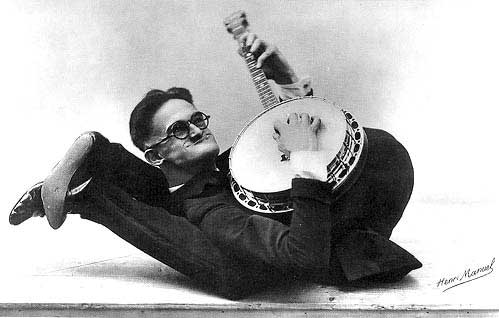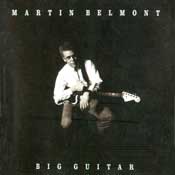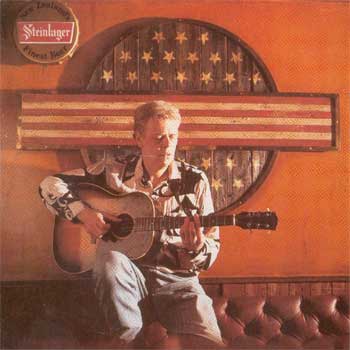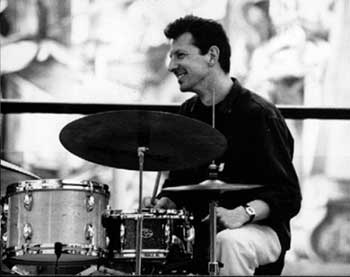Hank's band of LOST COWBOYS is packed with all-star hard-core country musicians:
Reg Meuross - vocals, banjo and guitar. Ex - Panic Brothers, "One of Britain's finest singer-songwriters" -- Time Out. Finest high tenor voice this side of the Atlantic. "SHORT STORIES" is his new critically acclaimed CD.
Martin Belmont - Stratocaster and 6-String Bass, ex-Graham Parker & the Rumour, Nick Lowe, Elvis Costello, Johnny Cash. Best hard core country guitarist around. Hear him ride the whammy bar on the 6-string bass and tremble. A giant on his CD "BIG GUITAR".
Kevin Foster - bass guitar. Doll by Doll bassist goes hard country. A powerhouse of C&W and honky tonk rhythms. In demand on the London roots music scene.
Roy Dodds - drums. Ex-Fairground Attraction, plays with Eddie Reader and has produced her new album in 2000. Attached at the rhythmic hip to Kevin Foster.
Hank's Uncle Ernest who taught Hank all he knows about simultaneous Gurning (the ancient art of face pulling) while playing the banjo with his arse
Reg has been a member of Hank’s band since the recording of the Stormy Horizons LP and has managed to maintain a parallel solo career. He first emerged onto the British acoustic music scene in 1986 when he formed the "Panic Brothers" with the comedian Richard Morton. Together they recorded one album called “In The Red” produced by Clive Gregson. Five years of successful touring and TV work followed, with appearances at Edinburgh, Glastonbury, Sidmouth and Towersey festivals. After the demise of the Panics, Reg formed the “Quintessentialy English Roots Band” "The Flamingos" with Martin Belmont, Chris Thompson and Alison Jones of "The Barely Works" & Bob Loveday from “The Penguin Café Orchestra”, They recorded one album called “Arrested In 1996 he released the critically acclaimed CD “The Goodbye Hat” and was nominated for several music awards, including best song for ‘Ring around the Roses’, a song which remains a favourite in the Lost Cowboys’ set. Reg’s Writing, Performing and acting credits include work with people as diverse as the famous French Composer Vladimir Cosma – who wrote the cult movie “Diva”, Gerard Depardieu; Not The Nine O’Clock News; Robbie Coltrane; Chris Difford; Gary Clark; Antonia Bird; Lenny Henry; Jeremy Hardy; Paul Merton, etc…
Reg's new album SHORT STORIES was released on OFFSPRING RECORDS in September 2004 for more details please go to www.regmeuross.com
Reg is represented by The Different Strings Agency.
For bookings etc please contact:
Lorraine Carpenter at Different Strings
1 West Street, Bedminster, Bristol BS3 3NN
Tel. 0117 9661968 or 07929 135744
lorraine@differentstrings.co.uk
“One of Britains finest Singer/Songwriters” - Time Out Magazine.
"Reg tells it with soul" - Nick Lowe
"The best high tenor voice this side of the Atlantic" - Hank Wangford
"There's something special about the way he writes and delivers a song" - Townes Van Zandt
Find out more at www.myspace.com/martinbelmont
ABOUT THE ARTIST
Martin Belmont was born on December the 21st, 1948, in Bromley, Kent. After attending Art College for five years, Martin,s musical career began by roadieing for seminal pub rockers Brinsley Schwarz, before lining up as lead guitarist with Ducks Deluxe in 1972. Along with the Brinsleys, American band Eggs Over Easy, Dr Feelgood and many more, Ducks Deluxe were stalwarts of the London Pub Rock scene. Their eponymous first album was a fine collection of no frills Rock,n,Roll, a real antidote to the prevailing progrock orthodoxy of the time. Surprisingly varied " Ducks Deluxe balanced full-tilt raunch- outs like Coast to Coast, and Eddie Cochran,s Nervous Breakdown, with Beatlesque pop on Please Please Please,, and country pastiches such as The West Texas Trucking Board,. Moreover if you play their classic Fireball, next to the Sex Pistols Satellite, you get the feeling that Malcolm Maclaren,s malcontents spent as much time listening in pubs as they did drinking!
RUMOUR HAS IT
After the second Ducks album, "Taxi to the Terminal Zone failed to capitalize on the good vibes created by their debut, the band split. Martin Belmont was far from idle though, helping to start the group The Rumour. The band hooked up with Graham Parker for six albums, umpteen tours of Britain, Europe, America, Australia, New Zealand and Japan as well as recording three LP,s in their own right. Martin,s razor sharp guitar breaks and solid chunky rhythm playing were one the musical highlights of a band overflowing with musical riches. Playing on Nick Lowe,s Jesus of Cool, album further enhanced Belmont,s reputation, and he toured with Elvis Costello and the Attractions on more than one occasion.
CARLENE AND NICK
After the Rumour had run its course, Martin became one of Carlene Carters CC Riders, playing on her Blue Nun, album and tours of Europe and the USA.>From 1982 to 1987, the Belmont Statocaster was heard with Nick Lowe as part of his Noise To Go, and Cowboy Outfit, backing bands. He played on all of Nick,s albums of that period as well as touring the U.S, Europe and Australia.
HANK
From 1987 to now Martin has recorded and gigged with Hank Wangford, the British Country stalwart, friend of Gram Parsons and TV personality with two country basedSeries on Channel 4. Martin provides many of the musical highpoints for the singing doctor,s live act and records, and in 1998 Martin and the rest of Hank,s Lost Cowboys toured the Falkland Islands.
FINALLY, A BIG GUITAR OF HIS OWN
Martin Belmont,s, first solo record "BIG GUITAR" was released by Demon records in 1995.The disc sees him at last stepping out behind his own name, showcasing not only his superior guitar stylings on Stratocaster and acoustic, but also his prowess on the rarely heard Fender Six String Bass. "BIG GUITAR has generous helpings of plangent six string bass magic on tracks such as "The West Texas Fender Bender, "The Man in Black, "Jurassic Jive and "The Rattler, as well as the hen,s-teeth rare Belmont vocals on the Howling Wolf classic "Howling for my Baby and Johnny Cash,s "Beans for Breakfast. Big John figures again with a cover of "Ring of Fire recorded with Zimbabwean Jit-jivers, The Bhundu Boys.
The album was recorded for the most part at former Attractions drummer Pete Thomas, basement studio in west London and apart from Martin,s six string virtuosity, features such crack rockin' cohorts as Pete Thomas himself, Geraint Watkins, Reg Meuross and Bobby Irwin. It,s a knockabout fun collection of eminently whistleable tunes, its effortlessly goodtime ambience guaranteed to put a smile on the sternest poker face!Martin calls the instrumentals on the disc, themes for imaginary westerns,big twangs in wide open spaces and picked acoustics on lazy railroads."Big Guitar" Can be bought at www.thewholewideworld.co.uk RECORDING BIOGRAPHY MAIN BANDS DUCKS DELUXE RCA and Skydog records.1972 1975
1973 Album " Ducks Deluxe "1974 Album " Taxi to the Terminal Zone "1975 E.P - " Jumpin, "
GRAHAM PARKER AND THE RUMOUR Phonogram, Mercury, Arista, Stiff and Hanibal records.1975 1981
1976 Album " Howling Wind "1976 Album " Heat Treatment "1977 Album " Max " (Rumour only)1977 Album " Stick to Me "1977 E. P. - " The Pink Parker "1978 Album " The Parkerilla "1978 Album - " Frogs, Sprouts, Clogs and Krauts " (Rumour only)1979 Album " Squeezing Out Sparks "1979 Album " Live Sparks "1980 Album " The Up Escalator "1980 Album " Purity of Essence " (Rumour only)
NICK LOWE and THE COWBOY OUTFIT Stiff, F Beat, CBS and Warner Bros records.1981 1986 (See also under sessions)
1981 Album " Nick the Knife "1983 Album " The Abominable Showman "1984 Album " The Cowboy Outfit "1985 Album " The Rose of England "
HANK WANGFORD Rough Trade and Sincere Sounds records.1987 Today
1990 Album " Stormy Horizons "1993 Album " Hard Shoulder to Cry On "1997 Album " Wake Up Dead "2000 E.P - " Wild Atlantic Sea "Sessions
This list does not include demo,s ( many ) and unreleased masters ( a few ).
1976 Single " I love the Sound of Breaking Glass " Nick Lowe1976 Album "Jesus of Cool " Nick Lowe1978 Single " Always in the Kitchen at Parties " Jona Lewie1980 Album " Rockabilly Blues " Johnny Cash1980 Album " Trust " Elvis Costello1980 Album " Black and Decker " Desmond Decker1981 Album " Rock and Roll Adult " Garland Jeffries1981 Album " Blue Nun " Carlene Carter1982 E. P. " Oh How Happy " Carlene Carter and Paul Carrack1982 Album " Suburban Voodoo " Paul Carrack1983 Album " Riding With the King " John Hiatt1987 Album " Pinker and Prouder than Previous " Nick Lowe1988 Album " Workers Playtime " Billy Bragg1991 Album " Arrested " Reg Meuross and The Flamingos1993 Album " Friends on the Road " The Bhundu Boys1994 Album " Declaration of Independence " Various Artists1995 Album " The Goodbye Hat " Reg Meuross1995 Album - " The Patsy Cline Review " Amanda Norman Sell1996 Album " As Love is my Witness " Amanda Norman Sell1996 Album " The Best of Eddie Grundy " Trevor Harrison2000 Album " Trigger Happy " Los Pistoleros2001 TV theme - "Moving Story" - Los Pistoleros2002 Album " Cult 45 " Los Pistoleros (Live recording)
Apart from the above list, many tours of Europe, America, Japan , Australia, New Zealand and almost the entire British Isles several times over, I recorded and released my own album " Big Guitar " in 1995. I was the Musical Director for Hank Wangfords T.V series " Big Big Country " and I produced, arranged and composed music for the " Comic Strip presents Jealousy " episode shown on B.B.C Two.




